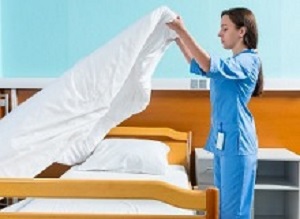 Washing contaminated hospital bedsheets in a commercial washing machine with industrial detergent at high disinfecting temperatures failed to remove all traces of Clostridium difficile (C. difficile), a bacteria that causes infectious diarrhoea, suggesting that linens could be a source of infection among patients and even other hospitals, according to a study.
Washing contaminated hospital bedsheets in a commercial washing machine with industrial detergent at high disinfecting temperatures failed to remove all traces of Clostridium difficile (C. difficile), a bacteria that causes infectious diarrhoea, suggesting that linens could be a source of infection among patients and even other hospitals, according to a study.
"The findings of this study may explain some sporadic outbreaks of C. difficile infections in hospitals from unknown sources, however, further research is required in order to establish the true burden of hospital bedsheets in such outbreaks," said Dr Katie Laird, head of the Infectious Disease Research Group, School of Pharmacy, De Montfort University, Leicester, UK and lead author of the study. "Future research will assess the parameters required to remove C. difficile spores from textiles during the laundry process."
Researchers inoculated swatches of cotton sheets with C. difficile. The swatches were then laundered with sterile uncontaminated pieces of fabric using one of two different methods – either in a simulated industrial washing cycle using a washer extractor with and without detergent or naturally contaminated linens from the beds of patients with C. difficile infection were put through a full commercial laundry where they were washed in a washer extractor (infected linen wash) with industrial detergent, pressed, dried, and finished according to current the National Health Service in the UK's healthcare laundry policy (Health Technical Memorandum 01-04 Decontamination of Linen for Health and Social Care (2016). Researchers measured the levels of contamination before and after washing.
Both the simulated and the commercial laundering via a washer extractor process failed to meet microbiological standards of containing no disease-causing bacteria, the study found. The full process reduced C. difficile spore count by only 40 percent, and this process resulted in bacteria from the contaminated sheets being transferred to the uncontaminated sheets after washing.
Researchers concluded that thermal disinfection conditions currently required by the UK National Health System are inadequate for the decontamination of C. difficile spores. There may be potential to spread C. difficile back into the hospital environment as linens could be a source for outbreaks at other healthcare facilities through businesses that collect, launder and redistribute rented linens to multiple hospitals and care facilities, as is the case at NHS facilities.
The research team, which also includes PhD student Joanna Tarrant, is working closely with the Textiles Services Association in the UK to continue research to find which combination of laundering parameters will remove C. difficile spores from hospital bedsheets.
Abstract
Objective: To quantify the survival of Clostridium difficile spores on hospital bed sheets through the United Kingdom National Health System (UK NHS) healthcare laundry process (Health Technical Memorandum (HTM) 01-04) in vitro and on bed sheets from patients with C. difficile through the commercial laundry.
Methods: Clostridium difficile spores were inoculated onto cotton sheets and laundered through a simulated washer extractor cycle using an industrial bleach detergent with sodium hypochlorite 15% and peracetic acid sour 14% (acetic acid and hydrogen peroxide; pH, 2–4). Spore survival on hospital sheets naturally contaminated with C. difficile was also assessed using a washer extractor plus drying and finishing cycles at a commercial laundry.
Patients: Naturally contaminated C. difficile bed sheets were taken from beds of patients that had previously been diagnosed with C. difficile infection (CDI) and had received care on an isolated C. difficile ward.
Results: The simulated washer extractor cycle, with an industrial detergent, demonstrated survival of 2 strains of C. difficile NCTC 11209 (0–4 colony-forming units [cfu] per 25 cm2) and ribotype 001/072 (0–9 cfu per 25 cm2). Before laundering, naturally contaminated bed sheets had an average spore load of 51 cfu per 25 cm2, and after washing, drying, and finishing, the spore load was 33 cfu per 25 cm2. Before and after washing, the C. difficile strain was identified as ribotype 001/072. Both the simulated and in-situ laundering processes failed the microbiological standards of no pathogenic bacteria remaining.
Conclusions: Clostridium difficile spores are able to survive laundering through a commercial washer extractor and may be contributing to sporadic outbreaks of CDI. Further research to establish exposure of laundry workers, patients, and the hospital environment to C. difficile spores from bed sheets is needed.
Authors
Joanna Tarrant, Richard O Jenkins, Katie T Laird
[link url="https://www.sciencedaily.com/releases/2018/10/181016110105.htm"]Society of Healthcare Epidemiology of America material[/link]
[link url="https://www.cambridge.org/core/journals/infection-control-and-hospital-epidemiology/article/from-ward-to-washer-the-survival-of-clostridium-difficile-spores-on-hospital-bed-sheets-through-a-commercial-uk-nhs-healthcare-laundry-process/8CEAE6BE5F6DFF8FC6543FD4E9726827"]Infection Control & Hospital Epidemiology abstract[/link]
